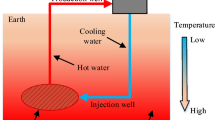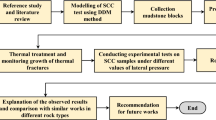Abstract
Understanding the temperature-dependent shear behaviors of rock discontinuity would be critical for evaluating the stability of deep underground engineering structure. However, there are few documents available in the literature. In this study, a number of direct shear tests were performed on granite discontinuities with equal/similar joint roughness coefficient (JRC) after high temperatures from room temperature to 800 °C under five levels of normal stress, respectively. A linear increase in peak shear strength can be observed as the temperature increased from room temperature to 400 °C, then followed by a non-linear decline trend as the temperature continuously increased until to 800 °C. Cohesion and internal friction angle exhibited similar trends (reverse S-shape) with the increase in temperature, while the extent of thermal treatments on the two parameters was different. Peak shear displacement and secant peak shear stiffness were also greatly influenced by the thermal treatments, and two temperature-dependent empirical equations with the inclusion of temperature were developed. From room temperature to 400 °C, thermal treatments caused little influence on the surface degradation, while such an effect gradually became prominent with the increase in temperature from 400 to 800 °C. The temperature-dependent shear mechanisms for the failure of the granite discontinuities can be divided into three types (i.e., physical, chemical and geometrical), while the thermally induced over-closure, stated by Barton, would not be suitable for the increase in discontinuities’ peak shear strength due to the different heating procedures.












Similar content being viewed by others
References
Alejano LR, Muralha J, Ulusay R, Li CC, Pérez-Rey I, Karakul H, Chryssanthakis P, Aydan Ö (2018) ISRM suggested method for determining the basic friction angle of planar rock surfaces by means of tilt tests. Rock Mech Rock Eng 51:3853–3859
Amadei B, Wibowo J, Sture S, Price RH (1998) Applicability of existing models to predict the behavior of replicas of natural fractures of welded tuff under different boundary conditions. Geotech Geol Eng 16:79–128
Asadollahi P, Tonon F (2010) Constitutive model for rock fractures: revisiting Barton's empirical model. Eng Geol 113:11–32
Barton N (1971) Estimation of in situ shear strength from back analysis of failed rock slopes. In: Proc. Symp. Int. Soc. Rock Mech. Rock Fractur, Nancy
Barton N (1973) Review of a new shear-strength criterion for rock joints. Eng Geol 7:287–332
Barton N (1982) Modelling rock joint behaviour from in situ block tests: Implications for nuclear waste repository design. ONWI-308. Office of Nuclear Waste Isolation, Columbus, OH, p 96
Barton N (2006) Rock quality, seismic velocity, attenuation and anisotropy. Taylor & Francis, Abingdon
Barton N, Choubey V (1977) The shear strength of rock joints in theory and practice. Rock Mech Rock Eng 10:1–54
Barton N, Bakhtar K, Bandis S (1983) Rock joint description and modelling for prediction of near field repository performance. Materials Research Society Annual Meeting, Boston
Belem T, Souley M, Homand F (2007) Modeling surface roughness degradation of rock joint wall during monotonic and cyclic shearing. Acta Geotech 2:227–248
Belem T, Souley M, Homand F (2009) Method for quantification of wear of sheared joint walls based on surface morphology. Rock Mech Rock Eng 42:883–910
Bilgin HA, Pasamehmetoglu AG (1990) Shear behaviour of shale joints under heat in direct shear. In: Rock joints: proceedings of a regional conference of the international society for rock mechanics, pp 179–183
Blanpied ML, Lockner DA, Byerlee JD (1995) Frictional slip of granite at hydrothermal conditions. J Geophys Res Solid Earth 100:13045–13064
Brace WF, Byerlee JD (1970) California earthquakes: why only shallow focus? Science 168:1573–1575
Drennon CB, Handy RL (1972) Stick-slip of lightly loaded limestone. Int J Rock Mech Min Sci Geomech Abstr 9:603–608
Fairhurst CE, Hudson JA (1999) Draft ISRM suggested method for the complete stress–strain curve for intact rock in uniaxial compression. Int J Rock Mech Min Sci Geomech Abstr 36:281–289
Goodman RE (1976) Methods of geological engineering in discontinuous rock. West, New York
Homand F, Belem T, Souley M (2001) Friction and degradation of rock joint surfaces under shear loads. Int J Numer Anal Met Geomech 25:973–999
Homand-Etienne F, Houpert R (1989) Thermally induced microcracking in granites: characterization and analysis. Int J Rock Mech Min Sci Geomech Abstr 26:125–134
Johansson F (2016) Influence of scale and matedness on the peak shear strength of fresh, unweathered rock joints. Int J Rock Mech Min Sci 82:36–47
Khamrat S, Thongprapha T, Fuenkajorn K (2018) Thermal effects on shearing resistance of fractures in Tak granite. J Struct Geol 111:64–74
Kim T, Jeon S (2019) Experimental study on shear behavior of a rock discontinuity under various thermal, hydraulic and mechanical conditions. Rock Mech Rock Eng 52:2207–2226
Kumari WGP, Ranjith PG, Perera MSA, Chen BK, Abdulagatov IM (2017) Temperature-dependent mechanical behaviour of Australian strathbogie granite with different cooling treatments. Eng Geol 229:31–44
Li Y, Oh J, Mitra R, Canbulat I (2016) A fractal model for large-scale opened rock joints. Rock Mech Rock Eng 49:913–925
Lockner DA, Summers R, Moore D, Byerlee JD (1982) Laboratory measurements of reservoir rock from the Geysers geothermal field, California. Int J Rock Mech Min Sci Geomech Abstr 19:65–80
Lockner DA, Summers R, Byerlee JD (1986) Effects of temperature and sliding rate on frictional strength of granite. Pure Appl Geophys 124:445–469
Magsipoc E, Zhao Q, Grasselli G (2019) 2D and 3D roughness characterization. Rock Mech Rock Eng. https://doi.org/10.1007/s00603-019-01977-4
Meier T, Backers T, Stephansson O (2009) The influence of temperature on Mode II fracture toughness using the punch-through shear with confining pressure experiment. In: Proceedings of the 3rd CANUS rock mechanics symposium, Toronto
Mitchell EK, Fialko Y, Brown KM (2013) Temperature dependence of frictional healing of Westerly granite: experimental observations and numerical simulations. Geochem Geophys Geosyst 14:567–582
Muralha J, Grasselli G, Tatone B, Blümel M, Chryssanthakis P, Yujing J (2014) ISRM suggested method for laboratory determination of the shear strength of rock joints: revised version. Rock Mech Rock Eng 47:291–302
Odedra A, Ohnaka M, Mochizuki H, Sammonds P (2001) Temperature and pore pressure effects on the shear strength of granite in the Brittle-Plastic Transition Regime. Geophys Res Lett 28:3011–3014
Ohno I (1995) Temperature variation of elastic properties of α-quartz up to the α–β transition. J Phys Earth 43:157–169
Olsson WA (1974) Effects of temperature, pressure and displacement rate on the frictional characteristics of a limestone. Int J Rock Mech Min Sci Geomech Abstr 11:267–278
Qin Y, Tian H, Xu NX, Chen Y (2020) Physical and mechanical properties of granite after high-temperature treatment. Rock Mech Rock Eng 53:305–322
Rong G, Peng J, Yao M, Jiang Q, Wong LNY (2018) Effects of specimen size and thermal-damage on physical and mechanical behavior of a fine-grained marble. Eng Geol 232:46–55
Saeb S, Amadei B (1992) Modelling rock joints under shear and normal loading. Int J Rock Mech Min Sci Geomech Abstr 29:267–278
Shao S, Ranjith PG, Wasantha PLP, Chen BK (2015) Experimental and numerical studies on the mechanical behaviour of Australian Strathbogie granite at high temperatures: An application to geothermal energy. Geothermics 54:96–108
Souley M, Homand F, Amadei B (1995) An extension to the Saeb and Amadei constitutive model for rock joints to include cyclic loading paths. Int J Rock Mech Min Sci Geomech Abstr 32:101–109
Stesky RM (1978) Rock friction-effect of confining pressure, temperature, and pore pressure. Pure Appl Geophys 116:690–704
Stesky RM, Brace WF, Riley DK, Robin PYF (1974) Friction in faulted rock at high temperature and pressure. Tectonophysics 23:177–203
Tang Z, Jiao Y (2020) Choosing appropriate appraisal to describe peak spatial features of rock joint profiles. Int J Geomech 20(4):04020021
Tang ZC, Sun M, Peng J (2019a) Influence of high temperature duration on physical, thermal and mechanical properties of a fine-grained marble. Appl Therm Eng 156:34–50
Tang ZC, Zhang QZ, Peng J (2019b) Effect of thermal treatment on the basic friction angle of rock joint. Rock Mech Rock Eng. https://doi.org/10.1007/s00603-019-02026-w
Tang ZC, Zhang QZ, Peng J, Jiao YY (2019c) Experimental study on the water-weakening shear behaviors of sandstone joints collected from the Middle Region of Yunnan Province P.R. China. Eng Geol 258:105161
Tatone BSA, Grasselli G (2013) An investigation of discontinuity roughness scale dependency using high-resolution surface measurements. Rock Mech Rock Eng 46:657–681
Tian H, Mei G, Jiang GS, Qin Y (2017) High-temperature influence on mechanical properties of diorite. Rock Mech Rock Eng 50:1661–1666
Ulusay R, Karakul H (2016) Assessment of basic friction angles of various rock types from Turkey under dry, wet and submerged conditions and some considerations on tilt testing. Bull Eng Geol Environ 75:1683–1699
Usefzadeh A, Yousefzadeh H, Salari-Rad H, Sharifzadeh M (2013) Empirical and mathematical formulation of the shear behavior of rock joints. Eng Geol 164:243–252
Valdez RD, Kitajima H, Saffer DM (2019) Effects of temperature on the frictional behavior of material from the Alpine Fault Zone, New Zealand. Tectonophysics 762:17–27
Yang SQ, Ranjith PG, Jing HW, Tian WL, Ju Y (2017a) An experimental investigation on thermal damage and failure mechanical behavior of granite after exposure to different high temperature treatment. Geothermics 65:180–197
Yang SQ, Xu P, Li YB, Huang YH (2017b) Experimental investigation on triaxial mechanical and permeability behavior of sandstone after exposure to different high temperature treatments. Geothermics 69:93–109
Zhang W, Sun Q, Hao S, Geng J, Chao L (2016) Experimental study on the variation of physical and mechanical properties of rock after high temperature treatment. Appl Therm Eng 98:1297–1304
Zhang F, Zhao J, Hu D, Skoczylas F, Shao J (2018) Laboratory investigation on physical and mechanical properties of granite after heating and water-cooling treatment. Rock Mech Rock Eng 51:677–694
Zhang Q, Li X, Bai B, Hu H (2019) The shear behavior of sandstone joints under different fluid and temperature conditions. Eng Geol 257:105143
Zhao Z, Dou Z, Xu H, Liu Z (2019) Shear behavior of Beishan granite fractures after thermal treatment. Eng Fract Mech 213:223–240
Zuo J-P, Wang J-T, Sun Y-J, Chen Y, Jiang G-H, Li Y-H (2017) Effects of thermal treatment on fracture characteristics of granite from Beishan, a possible high-level radioactive waste disposal site in China. Eng Frac Mech 182:425–437
Acknowledgements
The author gratefully acknowledges the support from the Natural Science Foundation of China under projects 41672302. Many thanks are also given to Xiao Yan Lai, Jiang Luo, and Tian Yuan Zhang for their assistance in performing the laboratory tests.
Author information
Authors and Affiliations
Corresponding author
Ethics declarations
Conflict of interest
The author declares that he has no conflicts of interest.
Additional information
Publisher's Note
Springer Nature remains neutral with regard to jurisdictional claims in published maps and institutional affiliations.
Rights and permissions
About this article
Cite this article
Tang, Z.C. Experimental Investigation on Temperature-dependent Shear Behaviors of Granite Discontinuity. Rock Mech Rock Eng 53, 4043–4060 (2020). https://doi.org/10.1007/s00603-020-02149-5
Received:
Accepted:
Published:
Issue Date:
DOI: https://doi.org/10.1007/s00603-020-02149-5




